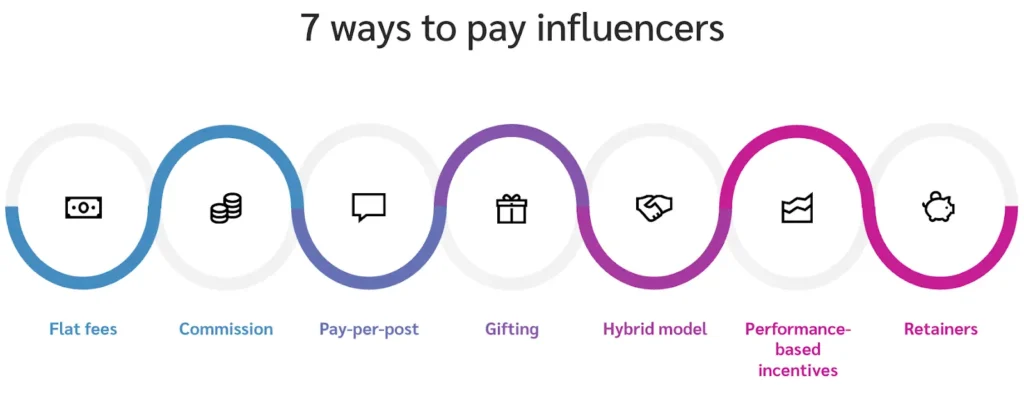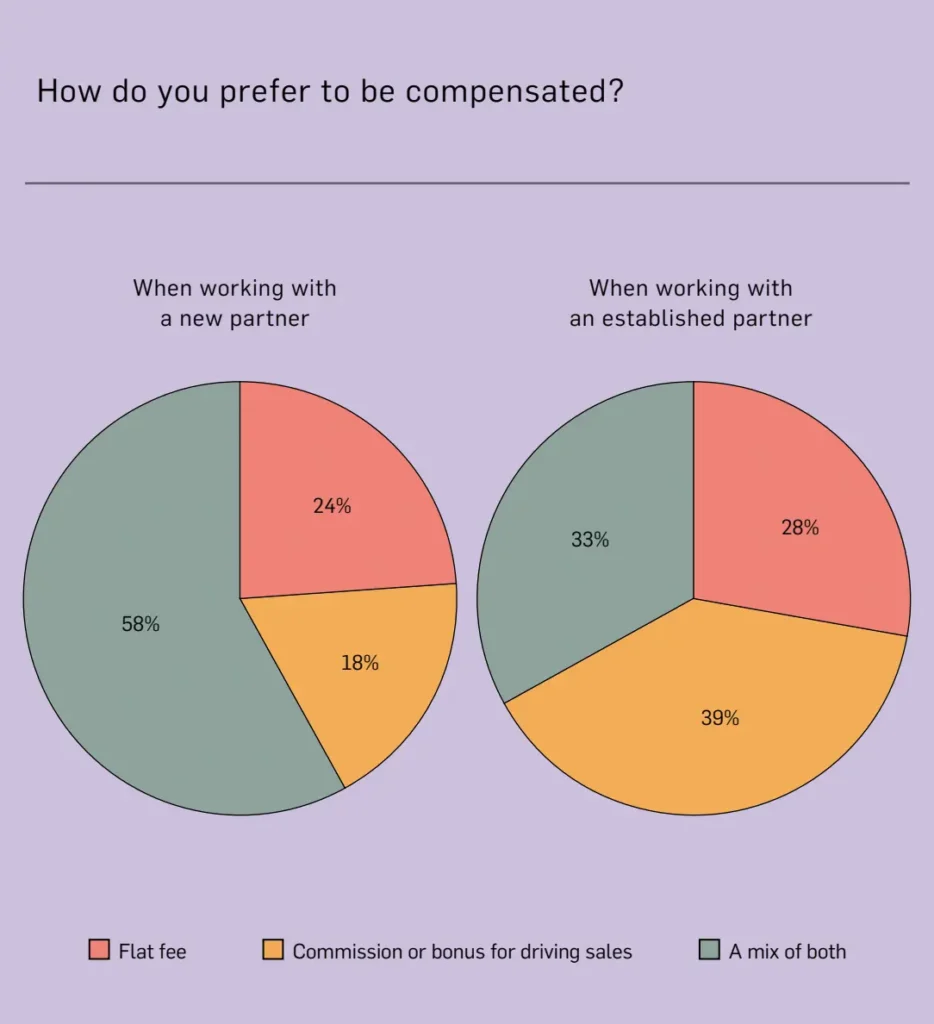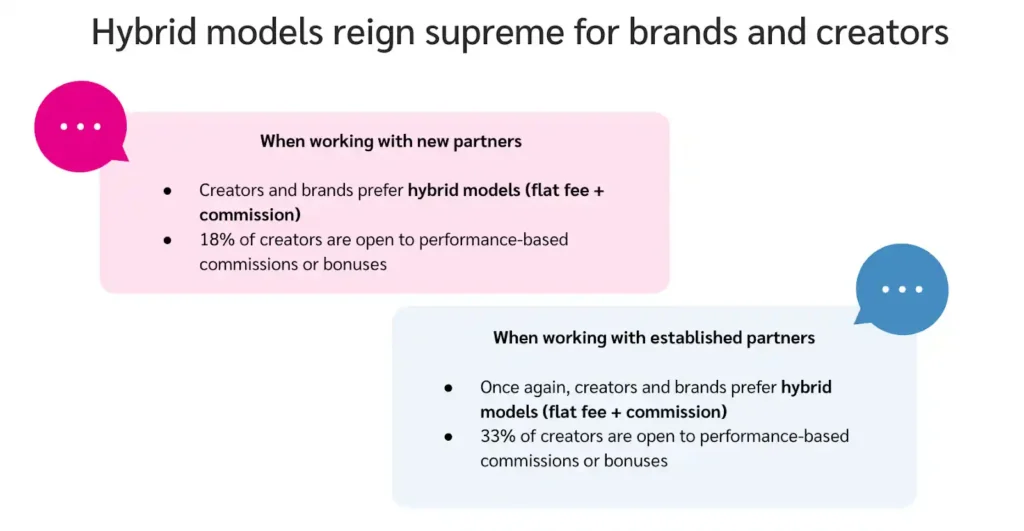Creator compensation is a hot topic. Payment terms play a pivotal role in retaining partners and enhancing performance outcomes. Influencers can boost your brand’s visibility and sales, so it’s vital to establish clear, fair, and mutually beneficial payment structures.
Compensation and the quality of a partnership significantly influence creators when choosing brands for long-term partnerships. So, the goal is to create a mutually beneficial partnership where your partners feel valued for their time and expertise as content creators.
Take the example of Vivino, the world’s leading online wine marketplace. The brand commissioned a mixed tier of influencers to promote its app. By aligning on compensation, the brand negotiated usage rights for user-generated content (UGC), gaining nearly 1.4 million impressions for its campaign. This highlights the array of choices available for fairly compensating creators.

Here’s an example of UGC from Vivino’s campaign by travel couple Bettina and Kyle.
Key takeaways from this blog
- The right compensation model depends on your program’s size, goals, and budget.
- Creators prefer to negotiate compensation with brands instead of take-it-or-leave-it offers.
- Most creators and brands prefer a hybrid compensation model (flat fees plus a performance-based commission).
- Some creators may dislike payments strictly in the form of gifts or discounts.
- Monthly retainers work well for long-term partnerships.
The right compensation model sets your campaign up for success
Choosing a suitable payment model is key to the success of your influencer partnerships. Different creators might have varying compensation preferences, highlighting the importance of flexibility and open dialogue between brands and their partners.
Our research underscores the need for brands to discuss and negotiate with creators rather than presenting take-it-or-leave-it offers. Fair compensation is more important than ever––43 percent of creators report they would end a collaboration if the pay didn’t meet their expectations, and 40 percent indicate that attractive compensation is a strong incentive for committing to long-term partnerships.
Fostering open communication and negotiating terms that benefit both parties sets the stage for a powerful collaboration. Starting on the right foot motivates creators and aligns their goals with yours, especially if there’s potential for lucrative earnings, such as performance-based incentives.

7 ways to pay influencers for long-term partnership success
Partnering with the right creators will get your brand in front of new audiences and drive higher engagement.
But, how you compensate creators can significantly impact the success of your collaboration. When choosing how to pay influencers, consider your program’s scope, overall goals, and budget.
Your chosen payment model is more than handing over a paycheck, though––it must align with your brand’s goals and the influencer’s expectations.
Be transparent: 80 percent of creators consider clear communication about compensation important. Remember that influencers provide a high-quality service that can make or break your campaign, so consider their needs and compensate them fairly, especially if you want to build a long-term relationship.
Explore the seven effective methods for compensating influencers:

#1 Flat fees take the pressure off new partners
One of the simplest ways to collaborate with creators is through a flat fee agreement. In this payment model, you pay the influencer a fixed amount regardless of campaign performance.
According to our research, most creators prefer this payment model when they team up with a brand for the first time. It lets them build trust without the pressure of hitting performance metrics.

A snippet from Ghosted no more: The secrets to thriving creator-brand partnerships.
Things to consider:
- Flat fees foster predictable budgets.
- The brand and creator should set clear expectations from the get-go.
- Influencers must receive a scope of work and outlined deliverables before creating.
Flat fees are perfect for:
- Established brands with clear campaign objectives and budgets.
- Product launches or promotional events where there is little room for error.
- Brands in consumer electronics, fashion, and beauty sectors.
#2 Commissions inspire creators to earn big wins
Commission-based payment models let influencers earn a percentage of sales or leads generated from their promotional efforts.
The commission model is your go-to if you want to tie influencer compensation directly to the results they drive. It allows your brand to reward performance, making it a win-win for brands and influencers.
Things to consider:
- Influencers earn a percentage of the sales or leads generated.
- Commission motivates influencers to maximize their impact.
- This model aligns the influencer’s efforts with your brand’s objectives.
- Its success is grounded in real-time tracking capabilities, such as those provided by impact.com / creator, which accurately attributes sales to high-performing influencers.
Pro tip: impact.com / creator’s platform offers robust tracking and reporting features to ensure accurate and transparent commission management.

impact.com / creator lets you customize proposals to potential partners, including compensation and deadlines.
Commissions are perfect for:
- E-commerce platforms and online services looking to drive sales or subscriptions.
- Relationships where the influencer has a proven track record and deep trust with their audience, so they have a better chance of conversion.
- Brands that are confident in their product and want to drive sales.
- Businesses keen on maximizing return on investment (ROI).

#3 Gifting enhances brand exposure (without a hefty investment)
Gifting is when brands offer creators their products or services as payment. Creators usually review these products or services in authentic UGC posts.
For example, with the help of impact.com’s creator-managed services team, luxury brand Coach, gifted their latest fragrance to a slew of influencers in exchange for UGC to create a buzz for its campaign. The brand received 211 pieces of content that reached an impressive 2.3 million people.

Creator Marta Pozzan promotes Coach’s fragrance to her 643k+ Instagram followers.
This method suits new or niche brands seeking exposure and credibility through influencer endorsements.
If you decide to use gifting as compensation, it’s best to proceed with caution––some creators may not appreciate the offer of gifts or discounts in place of flat fees or commissions.
As one creator told us: “Big turn off: discounted product/services vs free and paid to promote.” Free gifts don’t pay the bills for creators, so always consider adding a fee or commission in addition to gifts.
Things to consider:
- Gifting is an excellent way to gain visibility without a significant upfront investment.
- It encourages creators to experience and share your product authentically.
- Some creators may not be open to gifting, and most want to receive a fee in addition to gifts.
Gifting is perfect for:
- Startups and small businesses with limited marketing budgets or established brands (such as Coach) that are looking to create engagement.
- Brands in the beauty, tech, and specialty foods sectors, where product experience and endorsement significantly influence consumer decisions.
#4 Pay-per-post gives you room to test creator performance
A pay-per-post model can be the perfect fit when you want to engage your influencer partnerships. This approach compensates influencers for each piece of content—a post, story, or video—featuring your brand.
Things to consider:
- Pay-per-post is an effective model for campaigns focused on content creation across various platforms.
- It provides a clear structure for planning and budgeting.
- It’s great for testing a creator’s performance and adding more posts as you go.
- Influencers feel incentivized to deliver on time and bring leads.
Pay-per-post is perfect for:
- New or emerging brands aiming to build awareness across multiple channels.
- Brands that prefer a flexible approach to content creation and platform selection.
- Lifestyle, health and wellness, and food and beverage brands, where engagement across diverse channels is a priority.
#5 The hybrid model: a brand and creator favorite
You don’t have to choose between a flat fee and performance-based pay. Why not have the best of both worlds? The hybrid model does exactly that, blending a guaranteed payment with the potential for additional earnings based on performance.
Hybrid models let creators know where they stand but also provide incentives. More than 4 out of 5 agreed that they like performance bonuses and commissions but prefer them to be in addition to a flat fee.
For example, house products brand Resident Home gifted their bed-in-a-box mattresses to influencers in exchange for a piece of UGC to promote their product. The influencers proceeded to record videos of themselves unboxing and using the mattress, showcasing its effortless setup and advantages.
Recognizing the success of these posts, Resident Home then offered the influencers a performance-based incentive to inspire them to continue crafting fresh content highlighting their product.
This hybrid compensation approach kept creators engaged with Resident Home, allowed the brand to connect with audiences, and boosted sales through the creators’ informative and high-quality content.

Watch the full webinar, Unlocking the Power of Affiliate and Influencer Marketing for Full-Funnel Dominance, to get the full story from Resident Home and discover Amazon Music’s approach.
Things to consider:
- Additional earnings depend on performance metrics, including engagement rates, conversions, or sales.
- The potential for additional earnings is a strong incentive for influencers to create content that truly resonates with their audience.
- The hybrid model allows brands to budget their campaigns while rewarding creators for top performance.
Hybrid models are perfect for:
- Brands with different levels of influencer collaborations, from micro- to mega-influencers.
- Companies in competitive markets such as fashion, beauty, and gaming, where incentivizing influencers to exceed performance metrics can lead to higher engagement and conversions.

Based on impact.com’s research, this diagram highlights hybrid compensation models as the fan favorite for brands and creators—whether they’re new or established partners.
#6 Performance-based incentives can boost your content’s quality
Performance-based incentives reward influencers for surpassing specific targets or milestones. These targets may include exceeding a sales threshold or achieving a high engagement rate.
Things to consider:
- Bonuses can motivate influencers to put in their best effort.
- This effort can elevate content quality and result in better outcomes for the brand.
- Many influencers like the stability of a flat fee combined with commission.
Performance-based incentives are perfect for:
- Brands looking to motivate influencers to surpass campaign goals.
- Seasonal or peak sales periods, including holidays for retail brands and product launch phases for technology companies.

#7 Retainers nurture long-term partnerships
Retainers are great payment models for brands ready to cultivate long-term creator partnerships. Paying partners a monthly retainer helps them maintain their ongoing commitment to promoting the brand.
Things to consider:
- Retainer models encourage a deeper partnership, allowing influencers to become true ambassadors for the brand over time.
- Brands can budget for retainers for a specific period without any added costs.
- Creators gain financial security, knowing what they will earn each month.
Retainer models are perfect for:
- Brands seeking long-term advocacy and deeper partnerships with influencers.
- Industries where consistent brand representation plays a critical role, including luxury goods, automotive, and high-end lifestyle services.
FAQs
Payment terms for influencers vary depending on the chosen compensation model. Influencers could receive a flat fee per post or campaign, commissions based on sales or engagement, or a monthly retainer for ongoing partnerships. Each payment model offers different incentives and is chosen based on the brand’s specific goals and budget.
Gifting is ideal for businesses with a limited campaign budget. Gifting also works well for established brands looking to enhance engagement. It’s particularly effective in industries such as beauty, tech, and specialty foods, where product experience and endorsements significantly influence consumer decisions.
Yes, influencer content is paid media if the influencer receives compensation, including money, products, or services, in exchange for creating and sharing content about a brand.
Learning how to compensate creators pays off
Now that you have an idea of the seven types of influencer compensation models, you can move to the next step. Determining the right payment method for your brand depends on your budget, campaign goals, and the creator’s preferences. If you’re unsure, the hybrid model is a great place to start—creators feel motivated to do their best, and you can outline a predictable budget.
As you build partnerships with influencers, remember that impact.com / creator is the only platform that lets you customize your payment structure to include a mix of any payment method you choose. Ready to build successful long-term partnerships with creators? Take a look at our ultimate guide to influencer tiers ebook.





